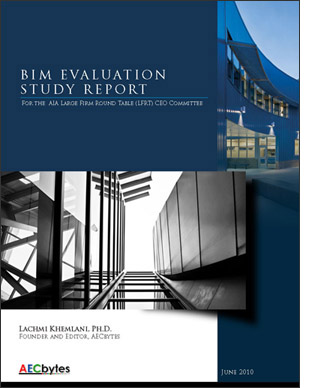
This research report captures the results of the BIM evaluation study that was conducted by Lachmi Khemlani, Ph.D., founder and editor of AECbytes. It was commissioned by the AIA Large Firm Round Table (LFRT) CEO Committee to provide the LFRT firms with an in-depth comparative evaluation of the main architectural BIM applications that are available. The study was conducted over a one-year period starting from June 2009 and ending in June 2010. The results are captured in a 163 page report that the AIA LFRT CEO Committee is now making available for purchase.
Additional details about the report are provided below, followed by the download link.
The bulk of the study is focused on evaluating the technical capabilities of each application, which was accomplished by installing and working with the latest version of the software that was available at the time of the evaluation. In addition, the study also looks at implementation aspects including pricing, training, technical support, and market position of the applications, as well as the long-term potential of their vendors. This information was compiled through market research, information gathered from the vendors themselves, and from talking with various firms implementing each of the applications.
The six BIM applications included in the study are listed below. The version of the application that was evaluated is also indicated.
For each of the six applications listed above, the report presents a detailed evaluation that includes:
After the detailed evaluation report of each application, a comparative evaluation chart of all the six applications is presented. This allows a quick side-by-side comparison of all the applications for each of the criteria listed in the evaluation tables.
The report also includes implementation studies of the six applications at various firms to explore how successfully each of them has been deployed, the challenges involved, training processes, and the overall level of satisfaction with the application. The case study firms include the following:
Copyright © 2003-2025 AECbytes. All rights reserved.
